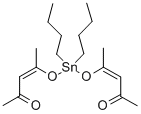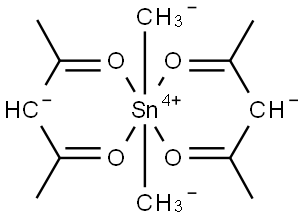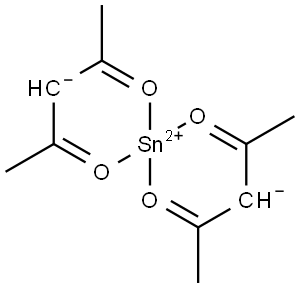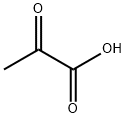DIBUTYLTIN BIS(2,4-PENTANEDIONATE)
Synonym(s):Sn(acac)Bu2
- CAS NO.:22673-19-4
- Empirical Formula: C18H32O4Sn
- Molecular Weight: 431.15
- MDL number: MFCD00077994
- EINECS: 245-152-0
- SAFETY DATA SHEET (SDS)
- Update Date: 2024-04-23 16:26:43

What is DIBUTYLTIN BIS(2,4-PENTANEDIONATE)?
The Uses of DIBUTYLTIN BIS(2,4-PENTANEDIONATE)
Dibutyltin Bis(acetylacetonate) is used in method for preparing silicone sealant for rail transit
Properties of DIBUTYLTIN BIS(2,4-PENTANEDIONATE)
| Melting point: | 26 °C(lit.) |
| Boiling point: | 150 °C(lit.) |
| Density | 1.22 g/mL at 25 °C(lit.) |
| vapor pressure | 0.038Pa at 25℃ |
| refractive index | n |
| Flash point: | 130 °F |
| form | liquid |
| color | pale yellow to amber |
| Specific Gravity | 1.21 |
| Hydrolytic Sensitivity | 4: no reaction with water under neutral conditions |
| Exposure limits | ACGIH: TWA 0.1 mg/m3; STEL 0.2 mg/m3 (Skin) NIOSH: IDLH 25 mg/m3; TWA 0.1 mg/m3 |
| EPA Substance Registry System | Tin, dibutylbis(2,4-pentanedionato-.kappa.O2,.kappa.O4)-, (OC-6-11)- (22673-19-4) |
Safety information for DIBUTYLTIN BIS(2,4-PENTANEDIONATE)
| Signal word | Danger |
| Pictogram(s) |
 Flame Flammables GHS02  Corrosion Corrosives GHS05  Exclamation Mark Irritant GHS07  Health Hazard GHS08  Environment GHS09 |
| GHS Hazard Statements |
H228:Flammable solids H302:Acute toxicity,oral H314:Skin corrosion/irritation H317:Sensitisation, Skin H341:Germ cell mutagenicity H370:Specific target organ toxicity, single exposure H372:Specific target organ toxicity, repeated exposure H410:Hazardous to the aquatic environment, long-term hazard |
| Precautionary Statement Codes |
P210:Keep away from heat/sparks/open flames/hot surfaces. — No smoking. P260:Do not breathe dust/fume/gas/mist/vapours/spray. P280:Wear protective gloves/protective clothing/eye protection/face protection. P303+P361+P353:IF ON SKIN (or hair): Remove/Take off Immediately all contaminated clothing. Rinse SKIN with water/shower. P305+P351+P338:IF IN EYES: Rinse cautiously with water for several minutes. Remove contact lenses, if present and easy to do. Continuerinsing. |
Computed Descriptors for DIBUTYLTIN BIS(2,4-PENTANEDIONATE)
New Products
4-Aminotetrahydropyran-4-carbonitrile Hydrochloride (R)-3-Aminobutanenitrile Hydrochloride 4-AMINO-TETRAHYDRO-PYRAN-4-CARBOXYLIC ACID HCL 4-(Dimethylamino)tetrahydro-2H-pyran-4-carbonitrile 3-((Dimethylamino)methyl)-5-methylhexan-2-one oxalate 1,4-Dioxa-8-azaspiro[4.5]decane 5-Bromo-2-nitropyridine Nimesulide BP Aceclofenac IP/BP/EP Mefenamic Acid IP/BP/EP/USP Diclofenac Sodium IP/BP/EP/USP Ornidazole IP Diclofenac Potassium SODIUM AAS SOLUTION ZINC AAS SOLUTION BUFFER SOLUTION PH 10.0(BORATE) GOOCH CRUCIBLE SINTERED AQUANIL 5 BERYLLIUM AAS SOLUTION 2-Bromo-1-(bromomethyl)-3-chloro-5-nitrobenzene 2-Bromo-3-nitroaniline N-(3-Hydroxypropyl)-N-methylacetamide 3-Bromo-6-chloropyridazine 4-ethyl-3-nitrobenzoic acidRelated products of tetrahydrofuran








You may like
-
 Dibutyltin bis(acetylacetonate) CAS 22673-19-4View Details
Dibutyltin bis(acetylacetonate) CAS 22673-19-4View Details
22673-19-4 -
 1-Methyl-6-oxo-1,6-dihydropyridazine-3-carbonitrile 98%View Details
1-Methyl-6-oxo-1,6-dihydropyridazine-3-carbonitrile 98%View Details
99903-60-3 -
 1823368-42-8 98%View Details
1823368-42-8 98%View Details
1823368-42-8 -
 2-(3-(tert-butyl)phenoxy)-2-methylpropanoic acid 1307449-08-6 98%View Details
2-(3-(tert-butyl)phenoxy)-2-methylpropanoic acid 1307449-08-6 98%View Details
1307449-08-6 -
 Ethyl 3-(furan-2-yl)-3-hydroxypropanoate 25408-95-1 98%View Details
Ethyl 3-(furan-2-yl)-3-hydroxypropanoate 25408-95-1 98%View Details
25408-95-1 -
 2-Chloro-5-fluoro-1-methoxy-3-methylbenzene 98%View Details
2-Chloro-5-fluoro-1-methoxy-3-methylbenzene 98%View Details
1805639-70-6 -
 1784294-80-9 98%View Details
1784294-80-9 98%View Details
1784294-80-9 -
 Lithium ClavulanateView Details
Lithium ClavulanateView Details
61177-44-4
Statement: All products displayed on this website are only used for non medical purposes such as industrial applications or scientific research, and cannot be used for clinical diagnosis or treatment of humans or animals. They are not medicinal or edible.